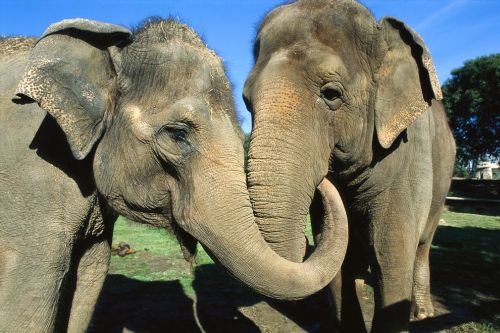Humans need gestures of love and affection, especially during tough times. Similar gestures have been noticed in the animal kingdom as well. Animals such as Cats, dogs, chimps, Gorillas, orangutans and birds such as crows, ravens, scrub jays are known to show empathy and love towards their stressed out member of the group. To this list, researchers have added the Asian elephants, who have been noticed to show gestures of love through gentle strokes and through various sounds, communicate with the distress member to express their empathy.
Elephants are known to be living in a strong social group of related females, young males and babies, led by an experienced matriarch and are believed to be empathetic towards each other. Just like we humans do, elephants also feel happy on a birth of a new born and howl on deaths.
Till date, there was not enough data or research work done to confirm the same. For the first time a research work done on captive Asian elephants (Elephas maximus) confirms this behavioral aspects of elephants. They are responsible mothers and are often raising young elephants of another mother. And help weaker animals of the group, showing signs of empathy towards one another.
The study led by lead researcher Joshua Plotnik who is a behavioral ecologist at Mahidol University in Kanchanaburi, Thailand and Frans de Waal, a primatologist and director of Emory University’s Living Links Center, to understand how these animals relate and feels for each other during a tough situation.
The research carried out at the Elephant Nature Park in the Mae Tang district of Chiang Mai Province, Thailand, included 26 elephants belonging to different age groups. In a time period of one year, these elephants were observed for up to two weeks each month and three hours on a daily basis.
The researchers noticed that during a stress situation, the elephants used their trunk to gently caress the agonized elephant and often make a chirp sound as a sign of reassurance. They were also noticed to place their trunk inside the mouth and on genitals in order to calm and assure the stressed elephant. At times, they even surround the suffering elephants making a protective circle.
Plotnik said that the elephants find another elephant in distress, they consoled using different gestures of trunk and making sounds, just like humans and chimpanzees hug someone feeling low. Rarely there has been a time when a distress elephant was not consoled and empathized by other members of the group. However, it is not completely understood how the expression of caress and affection benefits both the giver and the receiver elephants.
The findings from the study are exciting and show emotional and behavioral evolution in elephants, similar to those seen in humans. And understanding further more (in details as we have done in primates, dogs, or corvids), of what elephants feel and perceive about their surroundings, will help conservationist looking for a solution for these animals. In Asia, due to the consistent destruction of the habitat, elephants in search of food, often come across humans and thus arises a conflict. And therefore, we humans should understand and respect elephants and prefer taking measures to protect their habitat and give them their space to live as this planet belongs to them as well.




